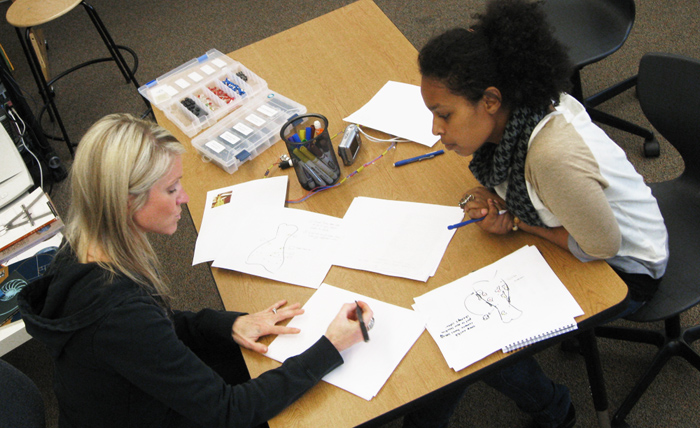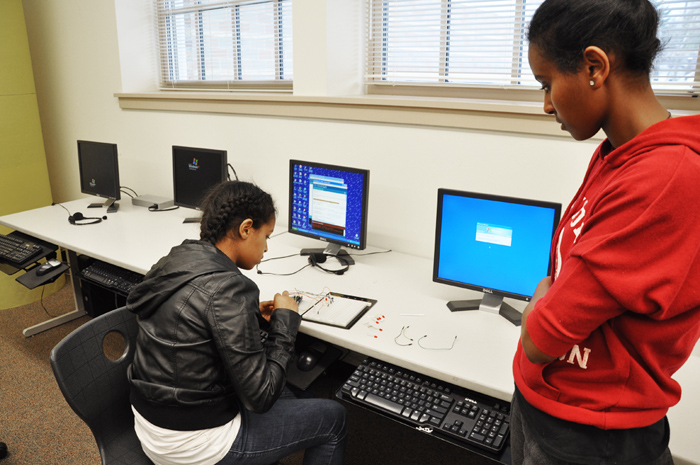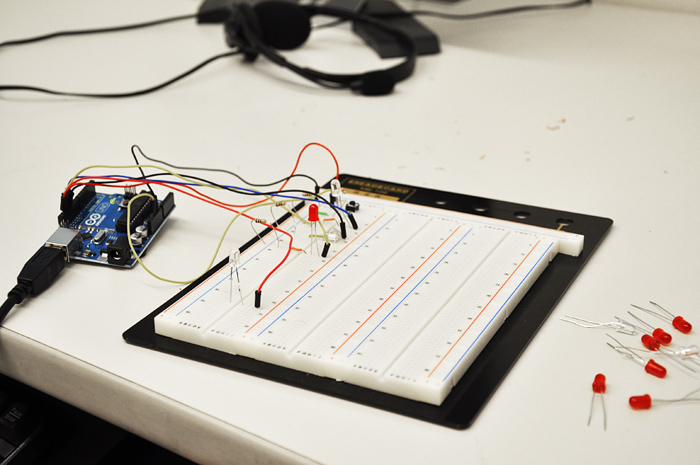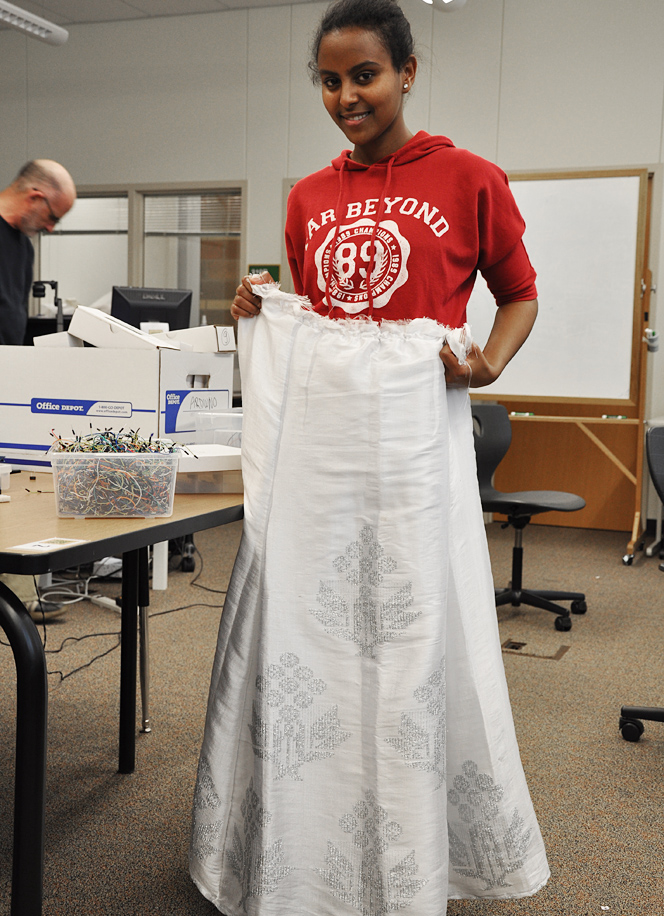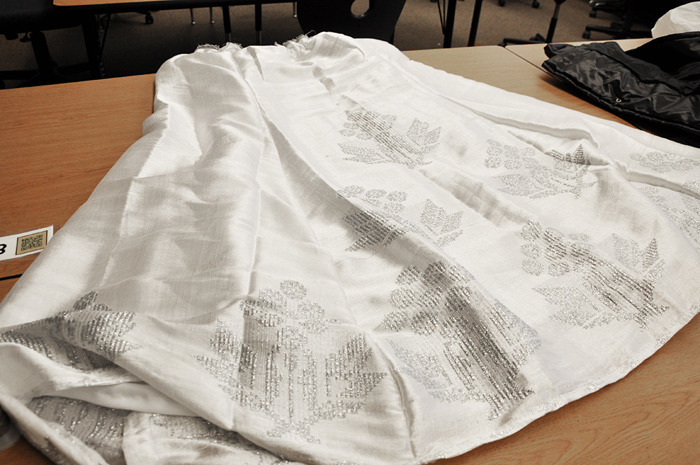Meron and Tsedey are making great progress on their interactive wedding gown. Here's an update from last month's post: For the past few months, I’ve been working with high school senior girls, Meron Shiferaw and Tsedey Tadesse, at Roosevelt High School in Seattle on a collaborative, cross-disciplinary project. The project introduces the young women to both technology and fashion and how to merge them into a new experience in the shape of an interactive gown. Throughout the months, they’ve been learning basic electronics, programming, fashion design and fashion construction. Here's a look at their progress...
As a recap to last month's post, the project had its roots in a course Meron took at Roosevelt HS last year — Introduction to Computer Science. That course, taught by Andrew Davidson, introduced students to the basics of computer science and engineering. So far, they've gone through 4 (out of 6) phases and are in the middle of construction and programming. Here's a recap and their progress...
1. Concepting and design
The first step for the students was to understand basic electronic theory, sensors, and interaction possibilities and concept ideas based on the limitations. When the students started the project, the original concept was to invite social play through an interactive gown (see last month's post for details). As they investigated what it would take to build a working prototype that included wireless capabilities and custom software that communicated with Twitter APIs, they decided to simplify the concept and scope it down to something that they could realistically build within the given timeframe.
Removing the complexity of wireless connectivity and open APIs, the students focused on a concept that used 9 LEDs and a remote control that participants could use to interact with the dress. For the concept, the students went back to their roots and decided to merge tradition Ethiopian culture with technology.
For their project, the concept uses technology to push the boundaries of traditional Ethiopian wedding gowns. The interaction takes the participant through a playful story of the modernization of traditional Ethiopian wedding gowns that started with handmade gowns with a single ornate pattern around the bottom edge and slowly became more ornate and shorter in length through the generations.
2. Intro to eTextiles
During this phase, they learned about different types of conductive threads, how to sew and work with the threads, and simple techniques to prepare electronics components for garment construction.
3. Intro to Arduino and electronics
During this phase and thanks to Roosevelt’s Computer Science teacher, Andrew Davidson, the students learned how to work with an Arduino board, basic electronics, and programming.

4. Intro to fashion design and construction
While learning the electronics and programming side of the project, they also learned about fashion design, pattern making, garment construction, and how to prepare a garment for circuit integration.
5. Integrating the circuit into the dress
This is Meron and Tsedey's current phase, so they're in the midst of working on production and learning how to integrate the circuitry into a garment. Once the full circuit was working without a glitch on the breadboard, it was time to start sewing it into the garment. The tedious hand-sewing took days for the students to complete, which was reminiscent of meticulous handcrafting of traditional Ethiopian wedding gowns. Finally, they had all 9 LEDs sewn into the dress behind the 9 fabric patterns along with the Lilypad, batteries and remote IR sensor that would allow the remote control to communicate with the dress.



It's working!
6. Programming
The students started with a basic program, but now that the circuit is in the dress, they wanted to make a few improvements on the design of the interaction. So, we had a design session to flush out the interaction. The students wanted to tell a playful story around the modernization of traditional Ethiopian wedding gowns, which began as ankle-length handmade gowns decorated with a pattern around the bottom seam. Through time, the patterns became more ornate and moved up the dress just as the seams got shorter. SO, they decided to use this for the interaction and mapped out the dress modes:
- Mode 1: Pulse along the bottom edge. This is reminiscent of long traditional gowns with patterns along the bottom seam.
- Mode 2: Twinkle along the bottom edge. Through time, the patterns started to become more ornate and complex.
- Mode 3: Pulse the top rows. Through time, the dresses started to become shorter
- Mode 4: Twinkle the top rows. Not only did they get shorter, but more patterns embellished the dress in more areas.
- Mode 5: Twinkle everywhere. The more modern dresses have more patterns and come in a variety of lengths
Using the remote, participants can change the speed of the pulsing and twinkling, change modes, and control individual LEDs in a fun and playful way.


Stay tuned for the March Presentation/Demo
The final presentation and demo will be in March and the students are working hard to finish the dress by then. Stay tuned as the dress starts taking shape and we'll share the final outcome then...
Related post: Electricfoxy mentors Roosevelt Students (part 1)


